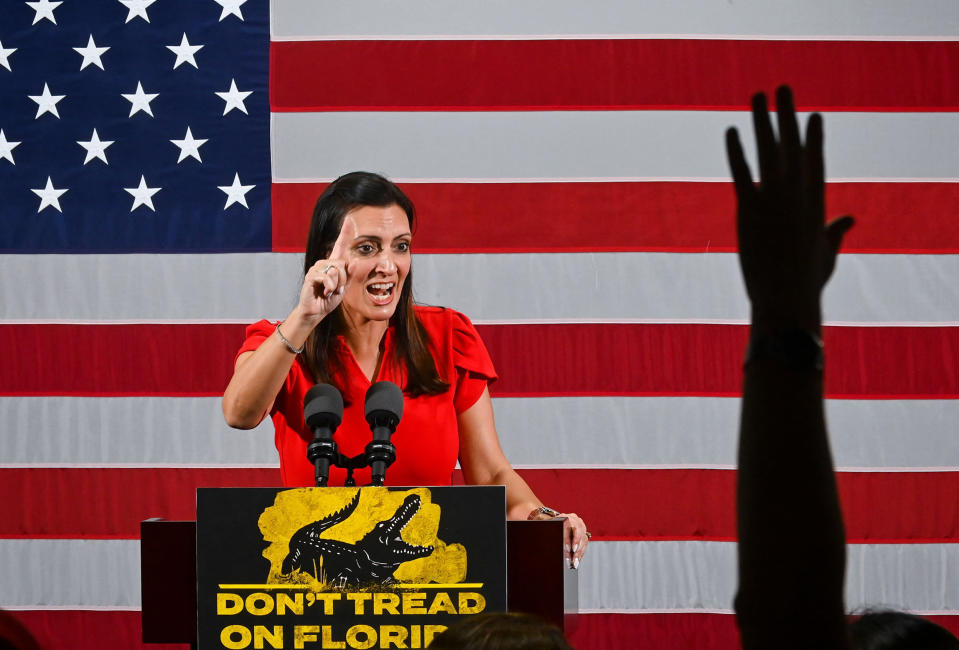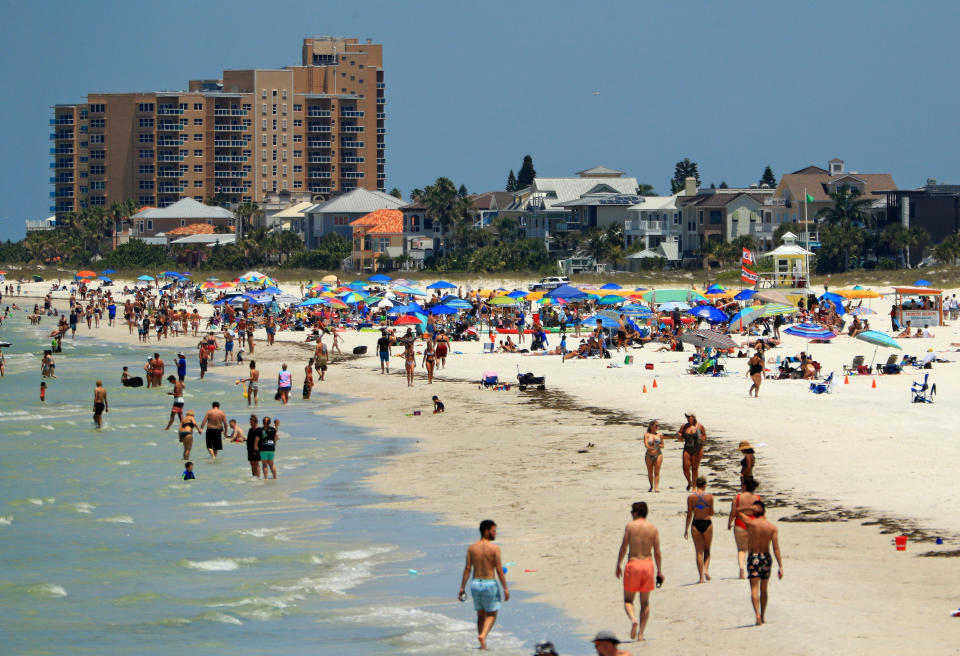Why Florida Latinos turned out in favor of Republicans
- Oops!Something went wrong.Please try again later.
- Oops!Something went wrong.Please try again later.
- Oops!Something went wrong.Please try again later.
MIAMI — Florida Democrats are reeling and coming to terms with devastating Election Day losses, particularly among Latino voters who turned out solidly for Republicans in statewide contests.
Republican Gov. Ron DeSantis won the state with a stunning 59% of the vote, compared to Democrat Charlie Crist's 40%. DeSantis outperformed former President Donald Trump’s 2020 Latino gains in Florida. DeSantis won 58% of the Latino vote, including 68% of Cuban Americans, 56% of Puerto Ricans, and 53% of all other Latinos combined, according to the NBC News exit poll. It was a jump from the 2018 results, when DeSantis narrowly beat Democrat Andrew Gillum by less than half a point, with 44% of the Latino vote.
Most Republicans running in the state won by large margins, turning Florida into a solid red state. Both chambers of the state legislature have supermajorities.
As the days have gone by, Democrats have been recognizing their failures and have cited several factors, including a lack of funding from national groups, Republicans' aggressive voter registration and turnout efforts compared to Democrats, and questions about the Democratic candidates.
When it comes to the Latino vote, DeSantis got substantial support from voters with no party affiliation as well as from those who previously voted Democratic. Florida International University professor Eduardo Gamarra, a Democrat, who had been saying for months that DeSantis is extremely popular among most Latino groups, said his messaging criticizing Democrats on immigration, crime and inflation resonated strongly with many of the state's residents.
By contrast, “Democrats started late, took the community for granted, and didn’t do the necessary research,” said Gamarra.
DeSantis flipped predominantly Hispanic Miami-Dade County and became the first Republican governor in 20 years to win what was once a Democratic stronghold.
DeSantis’ lieutenant governor Jeanette Nuñez, a Cuban American from Miami and a Florida International University graduate, helped the governor make inroads among Latino voters.
“She has all the descriptors that made her into an ambassador for this community,” said Gamarra. “Republicans identified from a strategic point of view that they needed to move early into South Florida at a very vulnerable time for this community.”

During DeSantis’ years as governor, Venezuela’s economy was in near collapse, Nicaragua’s president consolidated power — cracking down on dissent — Cuba’s government quashed historic protests, and Colombia elected its first leftist president, who is vehemently opposed by many Colombian Americans in Miami.
“Republicans became the real spokespeople for this community,” said Gamarra, referring to the governor, senators, and South Florida members of Congress. “They all coordinated very effectively with one message and it was uniform.”
“Latinos here were anxious about what was going on back home ... Republicans were saying: ‘It’s communism. Period.’ Democrats are looking for different shades of gray — even though in practice they didn’t really modify Trump’s policy in the region, but it’s the messaging," Gamarra said.
Others in Florida believe DeSantis’ pandemic policy to keep the state open paid off in the end, though it was a big risk at the moment.
“The No. 1 factor why Ron DeSantis became so popular in the state, and among certain segments of the population, was his pandemic policy — from a purely political perspective,” said Carlos Curbelo, a former Republican member of Congress and an MSNBC analyst.
DeSantis, who had been more moderate until the pandemic, gained national attention for keeping businesses and schools open. Residents of New York and other states that had strict Covid lockdowns flocked to the Sunshine State. DeSantis always hammers down the message that Florida is a “free state.” Over 80,000 people have died of Covid in Florida.
“A lot of Hispanic families rely on jobs where tipping is a major part of their income; those people were able to go to work,” said Curbelo. Children who were learning English did not suffer setbacks like in other parts of the country were schools were closed for longer periods, he added.

Republicans have been actively registering Hispanic voters for the past couple of years and have gone up in numbers from 640,049 registered Latino voters in 2020 to 697,911 in 2022, an increase of about 58,000. Meanwhile, the number of Democratic Latino registered voters decreased from 947,853 in 2020 to 901,481 in 2022. The number of Latinos registered with no party affiliation exploded from, 879,984 in 2020 to 966,795 in 2022.
“When you ask people why they are changing their registration, they say Democrats are veering too far to the left,” said Evelyn Peréz Verdía, a Democratic strategist and president of We are Más. "Those with no party affiliation are the Democrats' path to winning Florida."
She said that in a state where Hispanic voters are more moderate, Democrats need to be careful using the word “progressive,” which equates to “socialist” to some Latinos born in Latin America. Images of raised fists are emblematic of left-wing politicians and movements in countries throughout the history of Latin America.
Some Democrats have pushed back on the exit poll findings showing a 20-point jump for Republicans among the state's Puerto Rican voters.
Marcos Vilar, founder of Alianza for Progress, a progressive leaning voter outreach group, said Puerto Rican-heavy counties like Osceola and Orange had a lower turnout than in 2018. He said “small gains” are possible, the same way Trump made small gains with Puerto Ricans in 2020.
Vilar said one reason why DeSantis may have done a little better with Puerto Ricans is because Latino voters in general are a younger demographic and many recent candidates, like President Joe Biden, Sen. Bill Nelson, D-Fla., and Crist come from older generations that don’t connect well with Latinos.
“You see the drastic results, just four years ago with Gillum in the Puerto Rican community. He was very connected with this multiracial, diverse generation,” said Vilar. “I don’t think DeSantis sees it the same way, but his youth in comparison to other candidates that are the face of the Democratic Party today is probably a factor.”
But for others there is no question that DeSantis put together a coalition that helped transform Florida from the country's largest swing state to solid red, and this included broad support from Latino groups.
"There's no question that DeSantis received strong support from Florida Hispanic voters beyond Cuban Americans because, in order to put up the kinds of numbers that he put out, you can't just rely on Cuban Americans participating at a high rate," said Curbelo. "You need to have other Hispanics as well. The question about turnout, I think, is a distraction to the big story, which is the way DeSantis put together a coalition that netted him nearly 60% of the vote in what was the perennial swing state of the country."
This article was originally published on NBCNews.com

